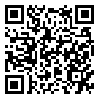BibTeX | RIS | EndNote | Medlars | ProCite | Reference Manager | RefWorks
Send citation to:
URL: http://jdisabilstud.org/article-1-1445-en.html
2- Department of Psychology, Islamic Azad University, Isfahan (Khorasgan) Branch
Background & Objectives: Social anxiety is defined as persistent and obvious fear of social and functional conditions. As a result, this belief occurs in the person who has acted shamefully and embarrassingly in this situation and others will judge him negatively. Prominent models of social anxiety emphasize the role of cognitive factors in creating this disorder. Cognitive models state that self-related beliefs are an essential factor in the persistence of social anxiety disorder. The Social Anxiety Questionnaire for Adults (SAQ-A30), originally designed to assess the social anxiety of Spanish students (12), is a self-report instrument that measures the level of social anxiety. This questionnaire is a multidimensional tool that measures social anxiety in people. One of the most important issues in the constructing questionnaires is that the measurement and test tools have desirable psychometric properties. Accordingly, the current study aimed to examine the psychometric properties (reliability and validity) and the standardization of SAQ-A30 among university students.
Methods: In terms of objectives and methodology, this research was applied and developmental research, respectively. Out of the statistical population, 389 students of the Islamic Azad University of Yazd City, Iran were selected by convenience sampling. Then, they completed the SAQ-A30 (Caballo et al., 2010) and the Social Phobia Inventory (SPIN) (Connor et al., 2000). For reliability assessment, using SPSS, the internal consistency method and the Cronbach α coefficient were employed. Additionally, for construct validity assessment, using LISREL, a confirmatory factor analysis was run. For convergent validity evaluation, the Pearson correlation coefficient was used at a significance level of 0.01. Initially, the English version of SAQ-A30, i.e., approved by the designers, was translated to Farsi. Then, the study questionnaires were distributed among the study samples. The instructions on responding to the questionnaires were explained to the study subjects. Besides, the respondents were assured that their collected information would remain confidential.
Results: The analysis data revealed that the Cronbach α coefficient for the whole SAQ-A30 was 0.88. The α values for the subscales of speaking in public; interaction with the opposite sex; assertive expression of annoyance, disgust, and displeasure; criticism and embarrassment; and interaction with strangers, were respectively obtained as 0.67, 0.74, 0.60, 0.72, and 0.68. The result of Confirmatory Factor Analysis (CFA) of the items of the SAQ-A30, using LISREL indicated that this scale has 5 factors with good fit indices. The fit indices were AGFI=0.86, RMSEA=0.05, CFI=0.96, NFI=0.91, and GFI=0.88. Furthermore, there was a significant difference between the components of speaking with people in authority (r=0.451, p=0.001), interactions with the opposite sex (r=0.614, p=0.001), assertive expression of annoyance, disgust, and displeasure (r=0.518, p=0.001), critique and embarrassment (r=0.489, p=0.001), and interactions with strangers (r=0.610, p=0.001), and the total scale (r=0.573, p=0.001) had a positive and significant relationship with Social Phobia Inventory (SPIN).
Conclusion: The present research findings support that SAQ-A30 is an appropriate diagnostic tool for identifying social anxiety among adults.
| Rights and permissions | |
 |
This work is licensed under a Creative Commons Attribution-NonCommercial 4.0 International License. |





